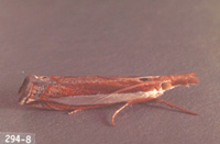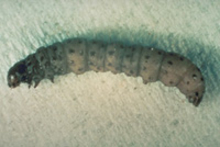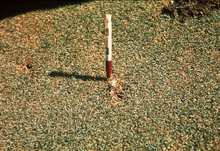Quick facts about sod webworms
The adults of sod webworms (Crambus species and Parapediasia species) are frequently called lawn moths.
- The larvae feed at night on grass blades.
- Symptoms first appear late spring and mid to late summer as small (size of a quarter) ragged brown areas.
How to identify sod webworms
Adult moths
They are light-colored moths with snouts, that make short, erratic, darting flights above the turf and are attracted to lights at night.
- When resting, the adult moths fold their wings back closely against their bodies, which gives them a very narrow appearance.
- Adult moths are 1/2 to 3/4 inch long.
- They are active in spring and mid-summer.
- The moths lay their eggs in the lawn.
Larvae
- Full grown larvae are brownish to grayish with black spots and a black head.
- They are 3/4 to 1 inch long.
- They are active in late spring and mid to late summer.
Damage caused by sod webworms
During the day the larvae hide in silk-lined tunnels or burrows at or slightly into the soil surface.
- Blade defoliation damage appears as brown scars where the blades are clipped off by the insect.
- Some species damage plant crowns or roots as well as blades.
- Two generations can occur in Minnesota.
- Heavy infestations of the second generation may seriously damage large areas of turf.
- Webworm adults are commonly seen, but larval damage is uncommon in Minnesota.
How to protect your lawn from sod webworms
Look for dew sparkling on the webs in the early morning or at dusk.
Look for sod webworms using flotation method
Use the flotation method to force the caterpillars to the surface, where they can be counted.
- Use a coffee can with the bottom and top removed and sink it into the turf
- Mix one ounce of mild dishwashing detergent into one gallon of water and pour this solution into the container.
- The soapy water irritates the insects and they will be seen floating in the solution.
- Scout for sod webworms in June and again in early August, since sod webworms have two generations per year.
- Tolerate sod webworms if there are up to 12 larvae per square feet.
Using pesticides
- Water the lawn thoroughly a day or so before applying any pesticide.
- Do not water for at least three days after treatment.
Some conventional pesticides that can be used for sod webworm control are: acephate, bendiocarb, carbaryl, chlorpyrifos, cyfluthrin, diazinon, ethoprop, halofenozide, isofenphos and trichlorfon.
Pesticides derived from natural organisms that can be used are: azadirachtin, Bacillus thuringiensis var. Kurstaki and nematodes.
CAUTION: Mention of a pesticide or use of a pesticide label is for educational purposes only. Always follow the pesticide label directions attached to the pesticide container you are using. Remember, the label is the law.
Reviewed in 2018




